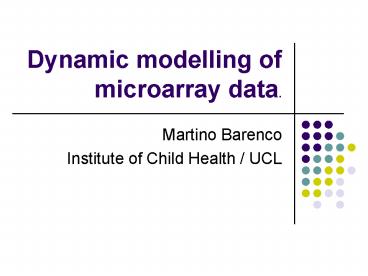Dynamic modelling of microarray data' - PowerPoint PPT Presentation
1 / 22
Title:
Dynamic modelling of microarray data'
Description:
Goal: predict targets of a known transcription factor in a ... Crispin Miller (Patterson Institute for Cancer Research) Daniela Tomescu (ICH) Mike Hubank (ICH) ... – PowerPoint PPT presentation
Number of Views:22
Avg rating:3.0/5.0
Title: Dynamic modelling of microarray data'
1
Dynamic modelling of microarray data.
- Martino Barenco
- Institute of Child Health / UCL
2
Outline
- Goal predict targets of a known transcription
factor in a complex response using dynamic models
and time course microarray data. HVDM Hidden
Variable Dynamic Modelling
- Principle Results (Genome Biology 2006)
- Techniques (R/Bioconductor implementation rHVDM)
3
Gene expression model
Transcript concentration Xj(t)
degradation rate
transcription rates
Xj(t)
transcription factor activity
Bj0 Sj3 Dj1
f(t)
4
Algorithm Principle
- Training step
- Inputs
- Previous biological knowledge known targets of
the - transcription factor
- - Expression values of those targets
Output - Transcription factor activity (the
hidden variable) - Kinetic parameters for the
training genes
- Screening step (for each single gene)
- Input
- - Transcription factor activity
- Expression profile of the gene
Output - Dependency status of the gene target
or not?
5
Training step (j training genes)
dX
(
t
)
j
B
S
f
(
t
)
D
X
(
t
)
-
j
j
j
j
dt
Screening step (j individual gene being screened)
dX
(
t
)
j
B
S
f
(
t
)
D
X
(
t
)
-
j
j
j
j
dt
6
The p53 network
Jun
myb
G2/M Arrest
DNA Damage
bcl2
CHK2
Survival
Active p53
Fas Pidd DR5
p53
Active ATM
ATM
Death Receptor
Bax p53AIF Puma
MDM2
p19Arf
Mitochondrial Apoptosis
E2F1
Jun-B p21
Rb
14-3-3
Rb/E2F1
Cell Cycle G1/S Arrest
CDK4
p73
7
Experimental setup
- Human T cells (MOLT4/p53 wild-type) submitted to
5Gy irradiation. - mRNA harvested 2,4,6,8,10,12 hours after
irradiation, and just before (0 hrs time point). - Affymetrix microarrays (HG-U133) were then run.
- Experiment was run in triplicates.
8
Results of training step activity profile of p53
9
Screening
- Q what are the other genes that are p53
activated? - Putative p53 targets must botha) Fit the model
wellb) Have a sensitivity coefficient Sjgt0
10
(No Transcript)
11
P21 part of training set
CD38 Uncovered by screening
12
Verification experiment
siRNA knock down of p53
HVDM predictions
13
Ingredients needed
1) ODE integrator
parameter values
2) Model fitting
Find set of parameter values s.t.
3) Want to take measurement noise into the data
into account 4) Specifically for the
Bioconductor implementation be reasonably quick
14
ODE integration
- Want to estimate slope of at
t6
- Slopeweighted sum of time points around t6
- i.e. the ODE is turned into a system of linear
equations
15
2) Model fitting
- Start with a random set of parameters
- Compute a solution
- Compare with data using a merit function
- Vary p systematically until a minimum value for
M(p) is reached.
16
Fitting algorithms
- Originally used simplex-based method
(Nelder-Mead) (GB paper) - Followed by a MCMC step to determine confidence
intervals (GB paper) - rHVDM (Bioconductor) uses Levenberg-Marquardt
(gradient-based). - By-product is the Hessian, which allows to
compute confidence intervals.
17
Difference between MCMC and LM confidence
intervals.
18
Importance of confidence intervals
- Biological data is inherently noisy. Dont want
to assume that measurement are exact. - example
- Genes with a flat profile would be a good fit to
the equation (Sj0) - Essential to identify these situations to detect
targets of the transcription factor
19
Parameter count reduction / identifiability
Replace f(t) with
Solution Let Sp211 (removes a
ambiguity) and f(0)0 (removes b ambiguity) ?
parameter count is reduced by 2
20
Confidence intervals importance II
Initial fitting
21
Measurement error
Algorithmic speed
Parameter identifiability
Parameter count reduction
Confidence intervals
22
Acknowledgements
- Sonia Shah (Bloomsbury Centre for Bioinformatics)
- Dan Brewer (Institute of Cancer Research)
- Crispin Miller (Patterson Institute for Cancer
Research) - Daniela Tomescu (ICH)
- Mike Hubank (ICH)
- Robin Callard (ICH)
- Jaroslav Stark (CISBIC, Imperial College)































